Fact:
On May 8, 2019, Taliban insurgents detonated an explosive-laden vehicle and then broke into American NGO Counterpart International’s offices in Kabul. At least seven people were killed and 24 were injured.

Despite the slight drop in the number of claims in February and March, the number of incidents claimed by Jihadi-terrorist groups in the Sahel has risen again to the record high of 129, first reached in January 2024. This confirms the overall trend first detected in June 2023. At that point the algorithms predicted the number of claims would easily surpass 100 per month, something we have witnessed in three of the four past months. Judging the number of claims and the overall impact of the claimed attacks by JNIM and both Islamic State branches, it is obvious that the security situation in the region continuous to deteriorate.
April is the third month in a row this year where the number of claims by JNIM surpasses both Islamic State’s branches. In total 66 claims were posted in April by az-Zallaqa Media, whereas both Islamic State branches published a total of 63 claims (50 ISWAP and 13 ISGS). As in previous months it is likely however that ISGS in particular continues to underreport its operations.
Again, several statements were published by JNIM accusing the Malian army, the Russian Africa Corps (the former Wagner Group) and the Burkinabe army of committing atrocities among the local population. Time and again JNIM presents itself as the protector of the local communities. Indeed, independent research by Human Rights Watch in late March seems to confirm that the military regimes in Mali and Burkina Faso, with the support of Russian mercenaries, have committed atrocities against civilians:
“Mali’s Russia-backed transitional military government is not only committing horrific abuses, but it is working to eliminate scrutiny into its human rights situation,” Ilaria Allegrozzi, senior Sahel researcher at Human Rights Watch, [said] in a statement Thursday.
On April 25 Human Rights Watch also confirmed a claim by az-Zallaqa Media dating back to February 28, 2024. The exact number of casualties that the terrorist-linked propaganda outlet az-Zallaqa had claimed concerning an attack by the Burkinabe army on the local population was independently confirmed by Human Rights Watch. No less than 223 civilians were killed in a random attack on a village in northern Burkina Faso on February 25, 2024. This was first highlighted by Polish Master student Pawel Wójcik and a few other researchers, as well as a report by Human Rights Watch.
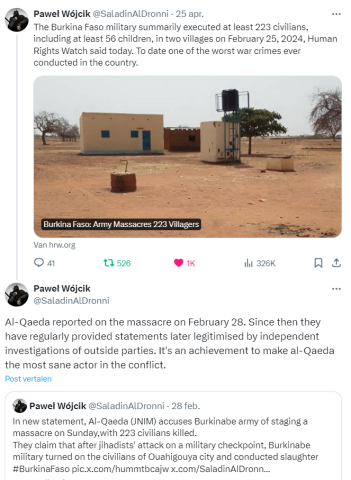
Picture 1: Thread on Twitter
April marks the third month in a row where claims posted by az-Zallaqa Media surpass those of both Islamic State branches in the region. While the difference in the number of claims between both terror networks is no longer very significant, the overall situation indicates that the operational capabilities of JNIM continue to increase. The number of attacks on the Russian Africa Corps also continue to rise. Twelve separate attacks were claimed by JNIM, on nine occasions some form of improvised explosive device (IED) was used. The number of Russian casualties remains unclear. The statements released by JNIM-linked propaganda outlets did not include precise figures of Russian casualties. In addition, no credible independent reports surfaced on the number of Russian casualties killed in Mali.
Furthermore, ISGS claimed four attacks on JNIM, killing at least 29 al-Qaeda fighters. The ongoing conflict between ISGIS and JNIM reflects the continuing competition between both terror groups for control over territory in Maili. Interestingly, while ISGS propaganda outlets focus on these attacks, the propaganda outlets of JNIM seem to ignore the conflict between both groups. The reasons for JNIM’s silence on this issue are currently unclear.
For the first time, all countries affected by terrorist violence in the region since reporting began were hit at least once this month. This demonstrates clearly that Jihadi-terrorist violence is spreading to the countries bordering the epicentre of the Sahelian terrorist operations. The seven countries affected were Mali, Nigeria, Burkina Faso, Niger, Cameroon, Togo, and Benin. As expected, slowly but steadily the conflict is becoming delocalized. This also increases the risk that additional countries will be affected by the spread of terrorist violence.
What might turn out to be the largest coordinated transnational Islamic State ideological operation yet was claimed on April 5 in an-Naba’ Magazine. According to Islamic State propaganda, during an operation of the Islamic State Hisba (Moral Police), the group distributed no less than 27.000 pamphlets among the population in Mali, Niger, and Burkina Faso. Such propaganda campaigns by the Islamic State seem to be increasing (cf the spread of material.) In addition to its violent operations, the Islamic State is increasingly focused on spreading and deepening its ideological message across the region.
Table 1: Claimed Attacks (December 2022 – April 2024)
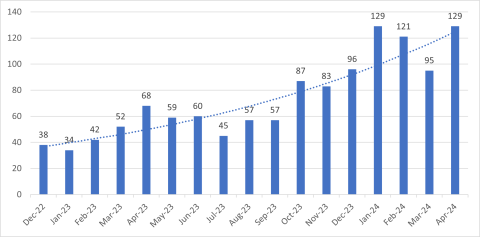
Table 2: Claimed Attacks per Group (December 2022 – April 2024)
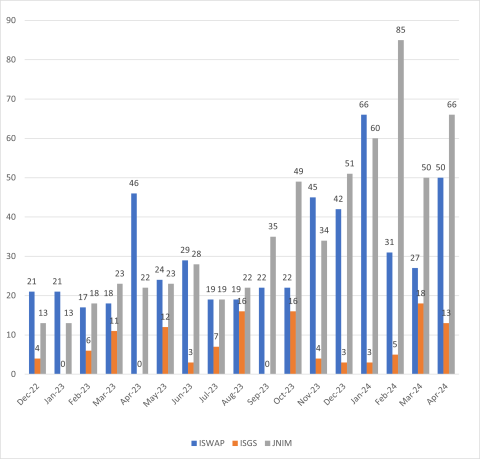
Table 3: Claimed Attacks per Country (December 2022 – April 2024)
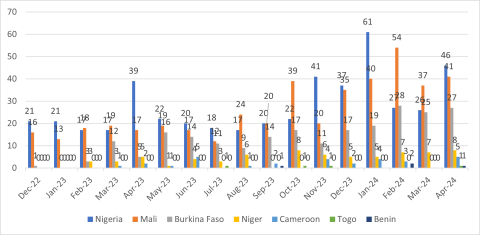
Nigeria again leads the statistics. Since reporting began in December 2022,Mali has ranked higher only four times: in August and October 2023 and in February and March 2024. As in previous months, most of the 46 claimed attacks were of low-level impact with only a handful of victims. On five occasions, attacks on the Christian population were claimed. In total, at least two Red Cross aid-workers were killed in Islamic State attacks, and one was reportedly wounded.
Mali featured 41 times in terrorist propaganda in April. 31 of these claims were posted by az-Zallaqa Media; and, as mentioned above, a significant number of claims were concerning massacres by the Malian army and the Russian Africa Corps. In a total of eight messages posted by az-Zallaqa Media at least 116 civilians were claimed to have been killed by the Malian army and the Russians. Since late April, the number of attacks by JNIM on the Malian-Russian coalition has been increasing dramatically. Only two attacks were claimed in the first half of the month; the other 10 date back to the 16th and 17th of the month and especially the week of April 22.
Burkina Faso was mentioned 27 times, only by az-Zallaqa Media. Most of the reports were on relatively small-scale attacks, resulting however in a total of at least 130 casualties. Two incidents were mentioned in which civilians were targeted, one time by the Burkinabe army, the other by Malian drones operating over the border area. No exact number of civilian casualties was included in these claims.
Niger was targeted by both JNIM, with five claims, and by ISGS on three occasions. In one of these propaganda posts, ISGS mentioned an attack by the Nigerien army on the local population, in which some civilians were allegedly wounded.
Cameroon was hit five times in the month of April. One attack by JNIM targeting a militia loyal to the government killed 13. The other attacks were of low impact and were all claimed by ISWAP.
On April 15 JNIM attacked Benin’s armed forces, resulting in five casualties.
One single attack on Togo was registered in a claim by az-Zallaqa Media. The Togolese army was attacked by JNIM, but no casualties were reported.
Table 4: Total number of attacks
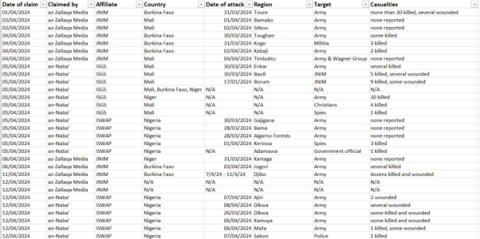
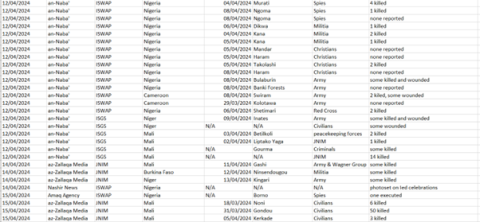
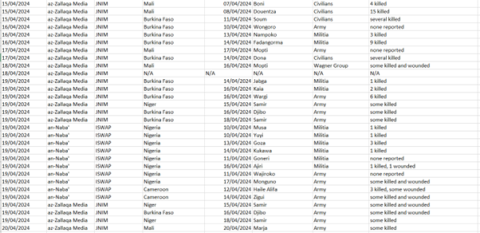
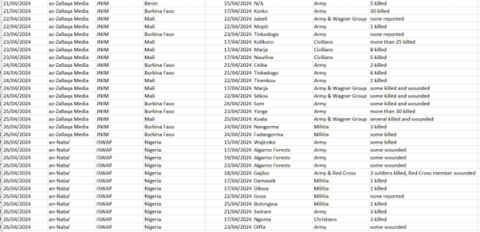

Az-Zallaqa Media published no less than 66 claims via its channels on Telegram, Element and its own dedicated website. This counts for the second largest amount of claims published in one month after the all-time high of 85 claims published in February 2024.
Twelve attacks on the Malian armed forces and the Wagner Group were registered. In total az-Zallaqa Media mentioned nine IED-attacks. The number of Russian casualties remains unclear as az-Zallaqa Media rarely reports on the number of Russian mercenaries killed.
No less than 10 social media posts concerned attacks by the armed forces and the Africa Corps/Wagner Group on the local population throughout Mali and Burkina Faso. According to these statements, there were at least 116 unarmed villagers murdered in Mali alone.
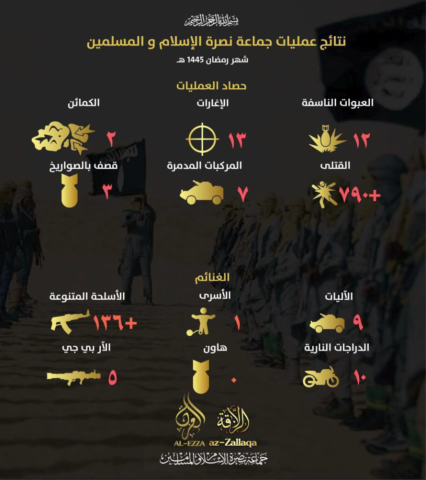
Picture 2: JNIM operations during the month Ramadan, 1445 A.H.
Table 5: Claims by JNIM
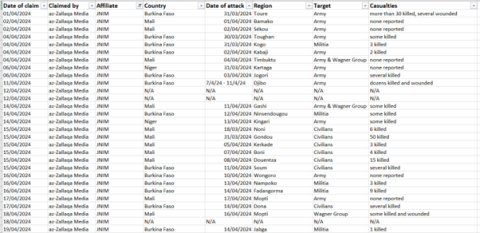
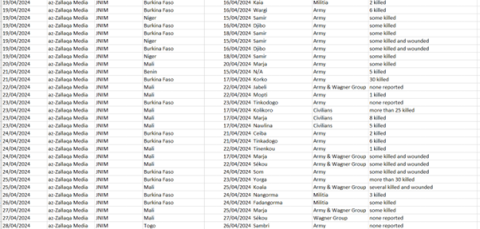

ISWAP claimed a total of 50 attacks. All of these targeted Nigeria except for four between late March and early April 2024, when several attacks on the Cameroonian military were claimed.
The most remarkable statements however were published shortly after the end of Ramadan to celebrate Eid al-Fitr. During this occasion ISWAP-linked propaganda outlets published dozens of pictures, in an apparent attempt to showcase its influence and manpower in the region.
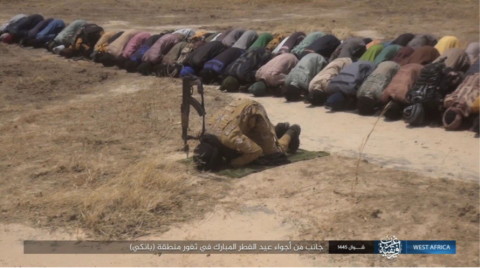
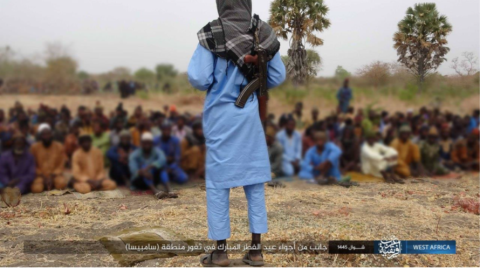
Picture 3 & 4 : Eid al-Fitr celebrations - ISWAP
Table 6: Attacks by ISWAP
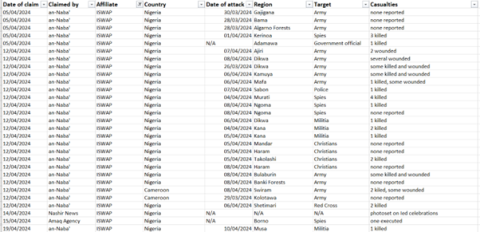

Only 13 statements were published by ISGS. The most important one was mentioned in an-Naba’ on April 5, 2024. That statement described a large transnational ideological propaganda campaign by ISGS. The group claimed that it had distributed over 27.000 pamphlets in Mali, Burkina Faso and Niger. In addition, four claims published concerned attacks on JNIM, the first dating back to January 17, 2024. According to these four statements, 29 JNIM fighters were killed.
One attack, killing four, was directed at the Christian population in Mali, killing four people. Remarkably an-Naba’ also mentioned an attack by the Nigerien military on civilians, wounding some. On April 3, ISGS claims to have killed two members of the United Nations in Mali: “two trucks and two armoured vehicles of the Crusader United Nations were burned, two drivers killed”. This is a curious claim since the United Nations Multidimensional Integrated Stabilization Mission in Mali (MINUSMA) ended its operations in the country at the end of December 2023 and is currently winding down its involvement in the country.
Table 7: Attacks by ISGS

As outlined last month, the risk of terrorist violence spreading to additional countries remains significant. April 2024 was the first month since reporting started in which no less than seven countries in the Sahel were targeted by the regional affiliates of al-Qaeda and the Islamic State. Propaganda outlets linked to these two terror networks claimed attacks in Nigeria, Mali, Burkina Faso, Niger, Cameroon, Togo, and Benin. It is clear, both by the number and the impact of these claimed attacks, that the situation in the entire region continues to deteriorate. We know that the regional affiliates of the Islamic State continue to under-report on their operations; this means that the actual situation on the ground is even more volatile than is reflected in the terrorist propaganda output. Furthermore, several governments in the region apparently continue to attack their own civilian populations, using counter-terror measures as a pretext. This will very likely lead to an acceleration of community radicalization and consequently terrorist recruitment in the region. Until now it was just JNIM highlighting these crimes, committed by government forces supported by Russian mercenaries. However, in April ISGS seems to have understood the propaganda value of highlighting such incidents and began to explicitly mention crimes against civilians in its propaganda output.
Apart from the massive media output by az-Zallaqa Media on JNIM’s behalf, maybe the most remarkable event this month was the report by an-Naba’ Magazine on April 5. According to this propaganda outlet linked to the Islamic State, no less than 27.000 pamphlets were distributed among the population in Mali, Niger, and Burkina Faso in an Islamic State Hisba (Moral Police) operation. Reporting on this remarkable transnational terrorist propaganda operation on the ground was clearly intended to demonstrate the breadth of Islamic Islamic State access to and influence over local communities in the region. Not only do terrorist attacks continue to proliferate, but so does proselytization. Now, both al-Qaeda and the Islamic State seem to be involved in active preaching and recruiting on a regional scale. This emphasis on ideological outreach and continued emphasis on the propaganda of both terrorist networks in the region detailing government and Russian mercenary violence against civilians will likely increase terrorist recruitment and therefore capacities over time. The chances of reversing the region’s volatile security situation seem ever more remote.
Extremists: Their Words. Their Actions.
Fact:
On May 8, 2019, Taliban insurgents detonated an explosive-laden vehicle and then broke into American NGO Counterpart International’s offices in Kabul. At least seven people were killed and 24 were injured.
Get the latest news on extremism and counter-extremism delivered to your inbox.